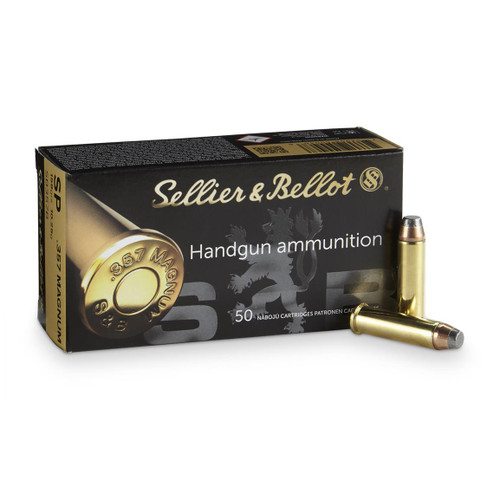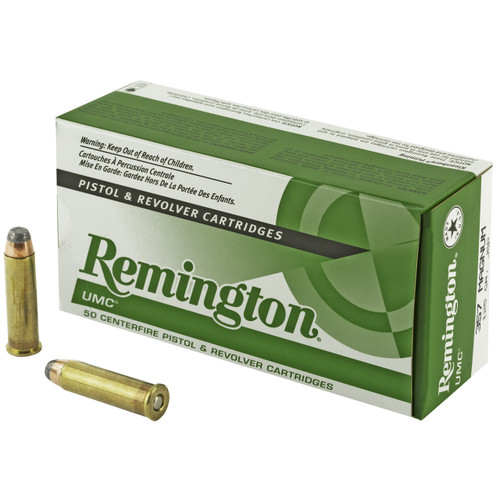.357 Mag Ammo

.357 Mag: In Depth
If you wanted a revolver round with buttkickin’ velocity in the 1920s, you pretty much had to handload one yourself. Considering what was going on at the time, if you were in the business of law enforcement back then, you might want something faster than you could get off-the-shelf. Factory loadings of the popular .38 Special ambled along at a measly 775/fps, and the .44 Special and even the .45 Auto Rim weren’t much quicker. This lack of speed was really turning into a problem – bullets weren’t penetrating the bad guys’ gear – so someone (or some company) needed to step in with an effective alternative. Ultimately, a handful of individual innovators and a few of the biggest firms in the US would work together to address this pressing need for speed.
It was Colt that answered the call commercially before anyone else, though their solution took the form of an autoloading cartridge. The .38 Super hit the scene right at the closing of the decade, sporting a 130-gr bullet traveling @ 1,300/fps, and could be chambered in a special variant of the M1911.
In short order, however, the Smith and Wesson .38-44 “Heavy Duty” revolver was released along with a loading of the same name – more or less a suped-up .38 Special, or even an early .38 Special +P. Instead of the .38 Special’s 158-gr. bullet @ 775/fps, this load was cranked up to 1,125/fps. Over the next few years, sixgun hero Elmer Keith’s experiments with extra-hot .38-44 loads and specially-designed bullets were a key influence for another man, Phil Sharpe, in his input to Smith and Wesson during their development of a new revolver: the .357 Magnum.
In 1935, Smith and Wesson would release the S&W .357 Magnum revolver to an eager and expectant public, with the FBI and other law enforcement outfits especially excited about the new firearm – notably, J. Edgar Hoover took delivery of serial no. 1 of the “Registered Magnum” series of the early guns. This unique production of Smith revolvers did not run for long due to wartime shifts in production at the end of the 30s, but by all accounts, the guns were incredibly special – one of a kind, really. Upon receiving an order for a new Magnum revolver, each of which was custom made, the company sent a registration card to the customer that could be completed and returned to Smith and Wesson. The customer would then receive an individualized certificate of registration detailing the owner’s name, barrel length, the front and rear sight configuration, the DA and SA trigger-pull weights, sight-in distance, sighting hold, and ammunition used to zero. These first-production .357 Magnums continue to fetch outrageous prices at auction to this day.
A few years after WWII, normal production of the S&W .357 Magnum resumed. The revolver, along with its cartridge, both enjoyed the distinction of “most powerful” during the first half of the 1950s. Popularity among law enforcement was quite high at the time, helped in no small measure by a lower-cost model known as the Highway Patrolman, released in 1954. However, the roughly twenty-year reign of .357 Magnum, not only as the sole “magnum” named cartridge in existence, but also as the biggest and baddest revolver round available, would end in 1956 with the introduction of the .44 Magnum.
While the .44 Magnum would steal away handgun hunters and later enjoy considerable celebrity status thanks to Hollywood (mostly Clint Eastwood, actually), law enforcement stuck with the .357 Magnum. The larger round was just too much recoil to handle for most folks, not to mention the extra weight of the gun plus ammunition when it came to carrying the thing. The S&W Models 27 and 28, Colt Python and others could also chamber and fire .38 Special and .38 Special +P which added to their appeal. In fact, .357 Magnum revolvers, often downloaded with .38 Special ammo, were common in law enforcement service up until the end of the 1980s after which autoloaders took over completely.
Starting in the early 50s, extremely lightweight frames, often with very short barrels, found their way into a number of .357 Magnum revolvers. These guns were popular both as backups to large-framed revolvers and as standalone carry pieces. However, due in part to some folks carrying them with .38 Special or .38 Special +P instead of .357 Magnum, and therefore limiting the potential effectiveness of their revolvers, carry of these compact guns continues to decline in favor of sub-compact 9mm Lugers and even .40 S&Ws. Still, this flexibility – the fact that you can also run .38 Special – is also a strength, and one of the key reasons that .357 Magnum firearms continue to sell so well.
So, although it’s a wheelgun round and no longer at the top of the handgun heap power-wise, the .357 Magnum is still a go-to cartridge in the age of semi-autos. For one, many people still carry .357s concealed, mostly due to the wide variety of compact revolvers on the market. Also, some folks continue to use the cartridge for handgun hunting or might instead pair it with a lever-action rifle to take deer-sized game. Plus, wheel guns are just fun to shoot! This cartridge won’t be leaving us anytime soon.
.357 Magnum: Guns
Both revolvers and lever-action rifles are both very popular with .357 Magnum shooters. Any firearm that will chamber this cartridge will also handle .38 Special and .38 Special +P loads, which are usually quite a bit cheaper to shoot. Revolvers with barrels less than 2” up through 8” and longer can be found, with frames made from lightweight alloys and heavy steels. Generally, the longer the barrel, and the heavier the frame, the better you’ll shoot. It’s a powerful round!
Revolvers
- Smith and Wesson Model 27 Classic
- Colt Python
- Ruger GP100
- Chiappa Rhino
- Smith and Wesson Model 340PD
- Ruger LCR
- Taurus Raging Hunter
- Colt King Cobra Target
- Ruger Blackhawk
Lever-Action Rifles
- Winchester Model 1892
- Marlin Classic Series 1894
- Henry Big Boy Steel Special
- Winchester Model 1873
- Rossi R92
Why Choose .357 Magnum?
Unless you really want to start small (think .22 LR), a .357 Magnum makes a great first revolver since it gives you the flexibility to work your way up through far milder .38 Special and .38 Special +P loads before you try out the fairly punishing standard pressure ammunition. Doing this might prevent you from developing the flinch that some – most – shooters develop with magnum revolvers. 357 Magnum has also been a law-enforcement and carry round since the beginning, so if you’re looking for “enough gun” when the threats are two-legged, this cartridge brings the beef. And, if you live in a straight-walled cartridge only hunting state, .357 Magnum will do some work, though it’s advisable to run it through a carbine or rifle for the velocity bump.
Target / Competition
- Even the very first “Registered Magnums” had premium target sights as an option. This cartridge was designed to shoot flat (at least for a handgun round) and go fast.
- This is a cartridge you can shoot through both revolvers and rifles.
Concealed Carry / Defensive Carry
- This used to be a widely carried cartridge among law enforcement and the general public in the US. It is still popular with some folks, due to its undeniable power.
- There are short (2” and shorter) revolvers available that are highly concealable, including some that are also extremely lightweight. However, please beware, as these are not at all pleasant to fire, and they’re designed for up-close shooting only.
Home Defense
- Provided you can manage the recoil, this cartridge is more than powerful enough to defend the castle.
- You might want to keep some hearing protection handy if you expect to encounter a threat indoors, however. .357 Magnum is extra loud and concussive compared with some of the other handgun rounds commonly in the mix for HD.
Hunting
- .357 Magnum has a lot more muzzle energy (550 lb/ft and up) than other handgun cartridges, but it’s still a handgun cartridge. Hunting with a handgun will be more challenging than with a carbine or rifle (for most people).
- There’s enough power here to kill a whole range of different critters, but if you’re setting out to handgun hunt in particular and don’t have the firearm yet, you might want to look at a .44 Magnum revolver instead.
- .357 Magnum ammo paired with a compatible rifle or carbine gives an extra velocity boost compared to a revolver, and can get up to 2,100/fps at the muzzle.
- Specialty lever-gun ammo for this application is available (Federal HammerDown).
.357 Magnum: Ammo Brands and Loadings
Like other revolver cartridges, .357 Magnum loadings use a wide variety of bullet styles and weights, and aren’t limited by how well they feed in a semi-auto. Lighter weight bullets tend to be found atop JHP defensive loads, with the most variety found in the 158-gr. range, and heavier bullets reserved for critter defense and hunting.
Brands
- Federal, CCI, Remington, Winchester, Fiocchi, Ammo Inc., PMC, Hornady, Norma, Aguila, Sellier and Bellot, Underwood, Buffalo Bore, Black Hills Ammunition
Standard Loading
- 158-gr. @ 1,250/fps (FMJ-FP, JHP, JSP are all common)
Bullet Types
- FMJ-FP (Full Metal Jacket - Flat point) - Target, competition
- JHP (Jacketed Hollow Point) - Self Defense
- JSP (Jacketed Soft Point) - Target, self defense
- LFN (Lead Flat Nose) - Hunting, bear defense
- SMC (Semi-Wadcutter) - Target, self defense
Bullet Weights
- 70-gr. to 110-gr. - Specialty monolithic, hollow point
- 125-gr. - Common weight for hollow points
- 158-gr. - Standard weight
- 180-gr. - Hard cast lead for bear defense, hunting
Velocities
- 70-gr. to 110-gr. - 1,200/fps to 2,100/fps
- 125-gr. - 1,200/fps to 1,600/fps
- 158-gr. - 1,200/fps to 1,500/fps
- 180-gr. - 1,100/fps to 1,500/fps
.357 Magnum: Frequently Asked Questions
.38 Special and .38 Special +P will chamber and shoot from a .357 Magnum firearm.
Not necessarily, but it will certainly be LOUD indoors! So will a .223 Carbine or any other rifle, to be fair.
Full-house .357 Magnum loads are pretty tooth-shaking to fire out of a compact revolver, but it’s definitely an option some people still choose. If you’re going to carry .38 Special or .38 Special +P in your .357 revolver, you’re better off going with a 9mm Luger these days. There’s no shortage of concealable revolvers out there. Just remember that ease-of-carry and shootability are usually on opposite sides of the weight spectrum!









